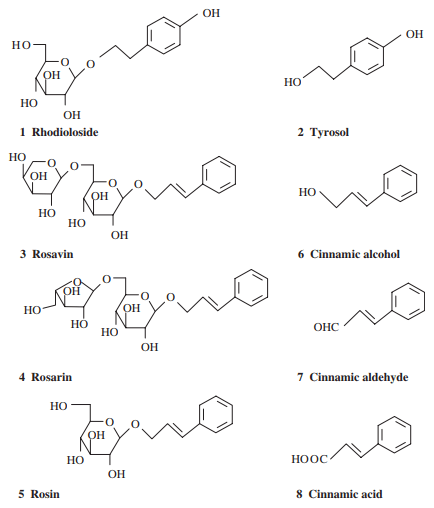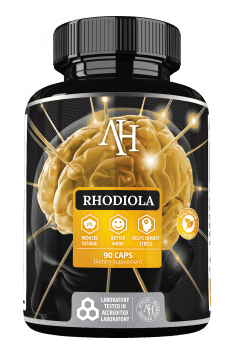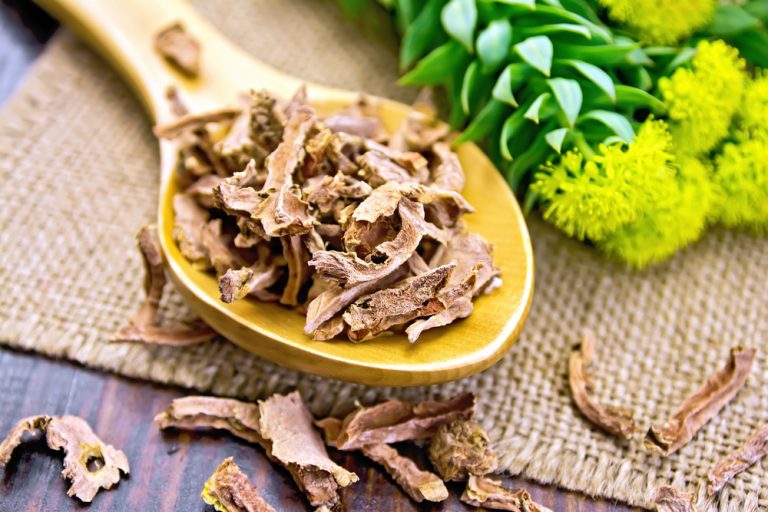Adaptogens, which until very recently where known only to professionals, currently have become the basis of supplementation for many people. Better mood and higher resistance to stress is a very attractive perspective and Rhodiola Rosea is a plant, the effectiveness of which is well-documented in scientific literature. Along with the increase of popularity, the choice of the preparations on the market is also wider. They differ in a few parameters, the most important of which seems to be standardization for active ingredients. What should we pay attention to when choosing a supplement with Rhodiola Rosea?
What is standardization?
First of all, we need to pay attention if standardization was applied at all. Some producers use simple dried product, which is not an extract and this often concerns low-price products. In the tables of other supplement we may also see the level of compression (4:1, 20:1, etc.), which may be mistakenly interpreted. It is not a standardized extract, but also a dried product with properly reduced volume. We do not really know how many ingredients are left there, which are important to us or even what amounts remained in the product. It is also the feature of rather cheap supplements.
We should be interested in the information on percentage standardization of concrete active substances. Such piece of information testifies to the fact that we certainly receive an ingredient demonstrating the required effect and we may precisely adjust dosing, when we know its concentration.
What standardization should be looked for?

A large majority of extracts is standardized for the content of rosavins, which is strongly rooted in the market. Some people claim that the higher their amount, the better the quality. Probably the majority of people think so. Therefore, it would definitely be a surprise for many that not rosavins should be of interest to us. The main ingredient that we should look for on the label are salidrosides (also called rhodiolosides). Since this statement is quite surprising, it would be nice to have some evidence. Let’s look at what was discovered in scientific experiments.
Benefits of salidrosides - clinical studies

The publication of Swedish scientists Mr. A. Panossian and et al. has contributed a lot to this topic. They decided to check the effects of the whole extract from Rhodiola Rosea as well as its particular, isolated ingredients on mental condition of rats. Among these ingredients there are saslidroside, rosavins, rosin, rosarin, tyrosol, cinnamic alcohol, cinnamaldehyde and cinnamic acid. These effects were measured by means of the Porsolt forced swimming test. It consists in placing an animal in a cylindric vessel with water for 15 minutes and repeating the test after 48 hours with the observation of the time of immobility. Between these two tests, the rats were administered active substances three times - immediately after the first test, 24 h later and an hour before the second test.
It was proven that the extract from Rhodiola Rosea [Swedish Herbal Institute (6% rosavin, 2,7% rhodioloside, 0,8% tyrosol)] provided better effects than imipramine (a classic antidepressant) and St John's wort extract. Among single ingredients the most effective were salidrosides, with 76.82% depression reduction, in comparison to the same dose of rosavins, which resulted in 56.6% improvement. On the basis of this, salidrosides cause stronger antidepressant effect and their high content should be desirable.
- Panossian et. al. „Comparative study of Rhodiola preparations on behavioral despair of rats” 2008
Antidepressant properties and characteristic energizing activity of Rhodiola Rosea result from the influence on the level of neurotransmitters. Some sources suggest the properties inhibiting the activity of monoaminoxidase, however, more and more often, concrete ingredients are mentioned, which have this ability. In the work of Daphne van Diermen et al. we may see the influence of various ingredients of Rhodiola Rosea on inhibiting MAO-A and MAO-B.
As it turns out, rosavins do not have influence on any of the fraction of monoaminoxidase. Salidrosides, on the other hand, to a certain extent (~36% of the value of the reference drug, selegiline) inhibit the activity of MAO-B, which may be reflected in higher concentration of dopamine and energizing effect. Interestingly, there are also other ingredients with MAO-inhibiting effect in Rhodiola, which are quite powerful. Rosiridin is in this aspect the most interesting, as it inhibits MAO-A with the effectiveness of 16% of the reference drug and as much as 84% MAO-B, which is a really impressive score. Unfortunately, we won’t find standardization for this ingredient in any supplement, so we may only hope for its presence.
Daphnevan Diermen et. al. „Monoamine oxidase inhibition by Rhodiola rosea L. Roots”
Journal of Ethnopharmacology Volume 122, Issue 2, 18 March 2009, Pages 397-401
Salidrosides for stress
Let’s go back again to the scientific contribution of Mr. Alexander Panossian. In his work in 2014, along with his companions, he analyzed the influence of the ingredients of Rhodiola on the expression of human genes. Three phyto-ingredients were chosen, which in this aspect are the most important - salidroside, tyrosol and trandrin. It turns our that each of these ingredients respectively influenced genes 1052, 1057 and 1062. The effects related to the influence on these genes are concerned with various aspects of health, including the functioning of the digestive system (163 genes), nervous system (95) and circulatory system (72) as well as metabolic disorders (63), mental disorders (62), endocrine (60) and behavioral disorders (50).
We reach for adaptogens and especially Rhodiola mainly in order to feel good, therefore we should focus here on the aspects influencing neurobiochemistry and mental condition. Among the mechanisms most affected by the influence of Rhodiola, we may enumerate i.a. signalization of receptors coupled with G proteins, the activity of glutamate receptors, the activity of ephedrine receptors and the pathways, in which cAMP takes part. Moving to practical effects, this results in decreasing the tendency to aggressive behaviors and alleviating emotionality, which confirms the results of the previous clinical and pre-clinical trials, testing the influence of Rhodiola Rosea on depression and anxiety disorders.
- Panossian et. al. „Mechanism of action of Rhodiola, salidroside, tyrosol and triandrin in isolated neuroglial cells: an interactive pathway analysis of the downstream effects using RNA microarray data.”
Phytomedicine. 2014 Sep 25;21(11):1325-48. doi: 10.1016/j.phymed.2014.07.008. Epub 2014 Aug 7.
As can be seen, along with diving deeper in the topic of the activity of Rhodiola we may encounter more and more interesting news. Is this the end of beneficial effects od salidrosides? Certainly not, as we may also encounter the reports of Mr. Shi at al. on neuroprotective effect of salidroside and its derivative, tyrosol. These two substances effectively protect the brain from the consequences of ischemia and thanks to antioxidant properties - from neurodegenerative activity of hydrogen peroxide.
Shi TY. et .al. „Neuroprotective effects of Salidroside and its analogue tyrosol galactoside against focal cerebral ischemia in vivo and H2O2-induced neurotoxicity in vitro.”
Neurotox Res. 2012 May;21(4):358-67. doi: 10.1007/s12640-011-9290-7. Epub 2011 Nov 18.
Dr. Carlo Cifani with his companions decided to check the influence of salidroside and rosavin on overeating. For this reason, female rats were properly prepared so that to provoke appropriate patterns. Three 8-day cycles were carried out. In each of them for 4 days food restriction was applied, by 66% of the normal value and for 4 days they were provided non-organic access to food. On the 25th day, i.e. on the day of the test, female rats were exposed to the activity of stress. The test consisted in making available food with high taste value and observing behavior of the animals. The extract from Rhodiola Rosea (3% rosavins, 3.12% salidroside) or isolated ingredients were applied to the rats an hour before making snacks available.
Only the individuals, which experienced food restrictions and stress reacted with binge eating during 15-60 minutes from obtaining access to food. The whole extract and isolated salidrosides were able to inhibit binge eating or eliminate it, depending on the dose. Such effects were not noticed in the group, which was provided only with isolated rosavins. It is yet another premise in order to be directed by the content of salidrosides in the supplement we buy and at the same time the information about the interesting influence of this herb on the regulation of behaviours related to regulating of food intake.
Cifani et. al. „Effect of salidroside, active principle of Rhodiola rosea extract, on binge eating.”
Physiol Behav. 2010 Dec 2;101(5):555-62. doi: 10.1016/j.physbeh.2010.09.006. Epub 2010 Sep 15.
Salidrosides for neuroprotection
In in vivo studies, also on rats, it was tested how salidrosides influence the nervous system, which is degenerated by the model of Alzheimer’s. The effects are very positive, as antioxidant and neuroprotective potential of salidrosides reversed all tested parameters, which deteriorated after causing the disease, including deterioration of memory, the ability to learn and numerous biochemical parameters. It is another premise, right after the above mentioned reports of Mr. Shi, which suggests protective influence of salidrosides on the nervous system.
Zhang et. al. „Salidroside attenuates beta amyloid-induced cognitive deficits via modulating oxidative stress and inflammatory mediators in rat hippocampus.”
Behav Brain Res. 2013 May 1;244:70-81. doi: 10.1016/j.bbr.2013.01.037. Epub 2013 Feb 5.
Rosavins vs salidrosides - summary
As can be seen Rhodiola owes much to salidrosides. We cannot completely disregard rosavins, as extracts with 3% of their presence and only 1% of salidrosides also demonstrated effectiveness in the studies. In the face of the information provided, which at many levels demonstrate superiority of salidrosides over rosavins, we should buy supplements with the high content of the former, in order for the sacrifice of the rodents taking part in the studies was not in vain.







2 Comments